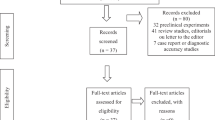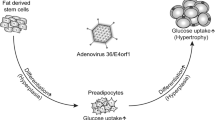Abstract
BACKGROUND:
Human adenovirus-36 (Ad-36) increases adiposity and paradoxically lowers serum cholesterol and triglycerides in chickens, mice, and non-human primates. The role of Ad-36 in human obesity is unknown.
OBJECTIVES:
To determine the prevalence of Ad-36 antibodies in obese and nonobese humans. To evaluate the association of Ad-36 antibodies with body mass index (BMI) and serum lipids.
DESIGN:
Cohort study. Volunteers from obesity treatment programs, communities, and a research study.
SUBJECTS:
Obese and nonobese volunteers at the University of Wisconsin, Madison, WI, and the Bowen Center, Naples, Florida. Obese and thin volunteer research subjects and 89 twin pairs at Columbia University, New York.
INTERVENTIONS:
Study 1: 502 subjects; serum neutralization assay for antibodies to Ad-2, Ad-31, Ad-36, and Ad-37; serum cholesterol and triglycerides assays. Study 2: BMI and %body fat in 28 twin pairs discordant for Ad-36 antibodies.
MAIN OUTCOME MEASURES:
Presence of antibodies to adenoviruses, BMI, serum cholesterol and triglycerides levels.
RESULTS:
Significant (P<0.001) association of obesity and positive Ad-36 antibody status, independent of age, sex, and collection site. Ad-36 antibodies in 30% of obese, 11% of nonobese. Lower serum cholesterol and triglycerides (P<0.003) in Ad-36 antibody-positive vs -negative subjects. Twin pairs: antibody-positive twins had higher BMIs (24.5±5.2 vs 23.1±4.5 kg/m2, P<0.03) and %body fat (29.6±9.5% vs 27.5±9.9%, P<0.04). No association of Ad-2, Ad-31, or Ad-37 antibodies with BMI or serum lipids.
CONCLUSIONS:
Ad-36 is associated with increased body weight and lower serum lipids in humans. Prospective studies are indicated to determine if Ad-36 plays a role in the etiology of human obesity.
This is a preview of subscription content, access via your institution
Access options
Subscribe to this journal
Receive 12 print issues and online access
$259.00 per year
only $21.58 per issue
Buy this article
- Purchase on Springer Link
- Instant access to full article PDF
Prices may be subject to local taxes which are calculated during checkout
Similar content being viewed by others
References
Lyons MJ, Faust IM, Hemmes RB, Buskirk DR, Hirsch J, Zabriskie JB . A virally induced obesity syndrome in mice. Science 1982; 216: 82–85.
Bernard A, Zwingelstein G, Meister R, Fabian Wild T . Hyperinsulinemia induced by canine distemper virus infection of mice and its correlation with the appearance of obesity. Comp Biochem Physiol 1988; 91B: 691–696.
Bernard A, Fevre-Montange M, Giraudon P, Hardin H, Fabian Wild T, Belin MF . Localization of viral proteins and RNA in hypothalamus of mice infected by canine distemper virus (French). Virology 1991; 313: 545–551.
Bernard A, Fevre-Montange M, Bencsik A, Giraudon P, Fabian Wild T, Confavreux C, Belin MF . Brain structures selectively targeted by canine distemper virus in a mouse model infection. J Neuropathol Exp Neurol 1993; 52: 471–480.
Nagashima K, Zabriskie JB, Lyons MJ . Virus induced obesity in mice. Association with a hypothalamic lesion. J Neuropathol Exp Neurol 1992; 51: 101–109.
Carter JK, Ow CL, Smith RE . Rous-Associated virus type 7 induces a syndrome in chickens characterized by stunting and obesity. Infection Immunity 1983; 39: 410–422.
Carter JK, Garlich JD, Donaldson WT, Smith RE . Influence of diet on a retrovirus induced obesity and stunting syndrome. Avian Dis 1983; 27: 317–322.
Gosztonyi G, Ludwig H . Borna disease: neuropathology and pathogenesis. Curr Topics Microbiol Immunol 1995; 190: 39–73.
Carp RI, Meeker H, Sersen E, Kozlowski P . Analysis of the incubation periods, induction of obesity and histopathological changes in senescence-prone and senescence-resistant mice infected with various scrapie strains. J Gen Virol 1988; 79: 2863–2869.
Dhurandhar NV, Kulkarni PR, Ajinkya SM, Sherikar AA . Avian adenovirus leading to pathognomic obesity in chickens. J Bombay Vet College 1990; 2: 131–132.
Dhurandhar NV, Kulkarni PR, Ajinkya SM, Sherikar AA . Effect of adenovirus infection on adiposity in chickens. Vet Microbiol 1992; 31: 101–107.
Dhurandhar NV, Kulkarni PR, Ajinkja SM, Sherikar AA, Atkinson RL . Association of adenovirus infection with human obesity. Obes Res 1997; 5: 464–469.
Dhurandhar NV, Israel BA, Kolesar JM, Cook ME, Atkinson RL . Increased adiposity in animals due to a human virus. Int J Obes Relat Metab Disord 2000; 24: 989–996.
Dhurandhar NV, Israel BA, Kolesar JM, Mayhew G, Cook ME, Atkinson RL . Transmissibility of adenovirus-induced adiposity in a chicken model. Int J Obes Relat Metab Disord 2001; 25: 990-–996.
Dhurandhar NV, Whigham LD, Abbott DH, Schultz-Darken NJ, Israel BA, Bradley SM, Kemnitz JW, Allison DB, Atkinson RL . Human adenovirus Ad-36 promotes weight gain in male rhesus and marmoset monkeys. J Nutr 2002; 132: 3155-–3160.
Preventing and managing the global epidemic of obesity: report of a WHO Consultation on Obesity. Geneva, 3–5 June, 1997. WHO/NUT/NCD98.1, Geneva; 1998.
Box GEP, Cox DR . J Roy Stat Soc Series B 1964; 26: 211.
Simo Minana J, Gaztambide Ganuza M, Fernandez Millan P, Pena Fernandez M . Hepatitis B vaccine immunoresponsiveness in adolescents: a revaccination proposal after primary vaccination. Vaccine 1996; 14: 103–106.
Bouchard C, Tremblay A, Depres JP, Nadeau A, Lupien PJ, Theriault G, Dussault J, Moorjani S, Pinault S, Fournier G . The response to long-term overfeeding in identical twins. N Engl J Med 1990; 322: 1477–1482.
Bouchard C, Tremblay A, Despres JP, Theriault G, Nadeau A, Lupien PJ, Moorjani S, Prudhomme D, Fournier G . The response to exercise with constant energy intake in identical twins. Obes Res 1994; 2: 400–410.
Bouchard C, Perusse L, Rice T, Rao DC . The genetics of human obesity. In: Bray GA, Bouchard C, James WPT (eds). Handbook of Obesity. Marcel Dekker, Inc.: New York; 1998. pp 157–190.
Chagnon YC, Pérusse L, Weisnagel SJ, Rankinen T, Bouchard C . The human obesity gene map: the 1999 update. Obes Res 2000; 8: 89–117.
Wigand R, Gelderblom H, Wadell G . New human adenovirus (candidate adenovirus 36), a novel member of subgroup D. Arch Virology 1980; 64: 225–233.
Hierholzer JC, Wigand R, Anderson LJ, Adrian T, Gold JWM . Adenoviruses from patients with AIDS: A plethora of serotypes and a description of five new serotypes of subgenus D (Types 43-47). J Infectious Dis 1988; 158: 804–813.
Vangipuram SD, Sheele J, Atkinson RL, Holland TC, Dhurandhar NV . A human adenovirus enhances preadipocyte differentiation. Obes Res 2004; 12: 770–777.
Whigham LD, Dhurandhar NV, Abbott DH, Schultz-Darken N, Israel BA, Kolesar JM, Strasheim A, Atkinson RL . Presence of obesity-associated human adenovirus-36 DNA in tissues of marmosets and humans. FASEB J 2001; 15: A300 (abstract).
Flegal KM, Carroll MD, Ogden CL, Johnson, CL . Prevalence and trends in obesity among US adults, 1999–2000. JAMA 2002; 288: 1723–1727.
Acknowledgements
We gratefully acknowledge Geoffrey Letchworth and Lisa Krugner-Higby for advice on virological aspects; Sharon Gathright, Tami Wolden-Hanson, Kathleen Taylor, Wenyen Zhang, and Alexis Strasheim for laboratory assistance; Chris Mullinax for data entry and analysis; and Virginia Schmidt for secretarial assistance. The work was supported by funds from the Wisconsin Alumni Research Foundation's Beers-Murphy Clinical Nutrition Center, and in part by NIH Grants RO1-DK52227 and R01-56277.
Author information
Authors and Affiliations
Corresponding author
Rights and permissions
About this article
Cite this article
Atkinson, R., Dhurandhar, N., Allison, D. et al. Human adenovirus-36 is associated with increased body weight and paradoxical reduction of serum lipids. Int J Obes 29, 281–286 (2005). https://doi.org/10.1038/sj.ijo.0802830
Received:
Revised:
Accepted:
Published:
Issue Date:
DOI: https://doi.org/10.1038/sj.ijo.0802830
Keywords
This article is cited by
-
Adenovirus 36 prevalence and association with human obesity: a systematic review
International Journal of Obesity (2021)
-
Adenovirus 36 seropositivity is related to obesity risk, glycemic control, and leptin levels in Chilean subjects
International Journal of Obesity (2020)
-
Influence of adenovirus 36 seropositivity on the expression of adipogenic microRNAs in obese subjects
International Journal of Obesity (2020)
-
Obesity and Diabetes in an Arab population: Role of Adenovirus 36 Infection
Scientific Reports (2020)
-
A personal look at the past and future of obesity science
European Journal of Clinical Nutrition (2020)



